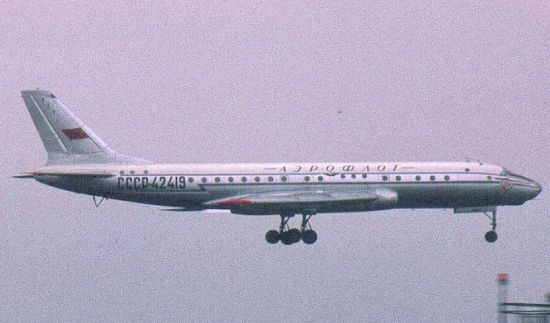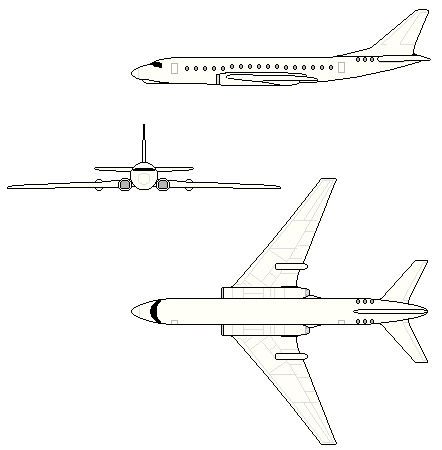|
||||||||||
|
|
||||||||||
|
||||||||||
|
|
||||||||||
 - -
|
|

|
Tupolev Tu-104 ASCC codename: Camel Medium-Range Jetliner |
|
DESCRIPTION:
The Tupolev Tu-104 was the second jet-powered airliner to enter service following the de Havilland Comet. Known as the 'Camel' in the West, the Tu-104 was developed in response to an urgent Aeroflot need for a modern airliner with better capacity and performance than anything in operation at the time. To speed the design process, Tupolev chose to develop a civil version of the Tu-16 (or Tu-88) strategic bomber. The new aircraft mated the swept wings, tail surfaces, and Mikulin AM-3 turbojet engines of the Tu-16 with a new wider pressurized fuselage accomodating 50 passengers. Passenger seating consisted of a small cabin in the forward fuselage and a large rear cabin, the two being divided by a section of raised flooring that passed over the center wing structure and was used as a galley on early models. Continuing improvements in the Mikulin engines permitted siginificant growth in the Tu-104, and production soon shifted to the 70-passenger Tu-104A. Although retaining the same fuselage, the uprated engines allowed an increase in maximum takeoff weight and the use of five-abreast seating in the main cabin. Further improvements were attained with the stretched Tu-104B fitted with new engines and able to accomodate 100 passengers, 30 seated in the forward cabin, 15 above the wing spars, and the remainer in the aft cabin. Some 200 total aircraft were built by the time production ended in 1960, and these continued in civil service with Aeroflot until 1981. A small number were also operated by the Czech national airline CSA that bought the Tu-104A configured for 81 passengers. Once the type was removed from civil service, several were transferred to the military as staff transports and zero-g cosmonaut trainers.
Data below for Tu-104B |
|
| HISTORY: | |
| First Flight | 17 June 1955 |
|
Service Entry
|
(Tu-104) 15 September 1956 (Tu-104B) 15 April 1959 |
| CREW: |
up to five flight crew: pilot, co-pilot, navigator, radio operator, flight engineer
|
| PASSENGERS: |
(Tu-104) 50 (Tu-104A) 70 (Tu-104B) 100 (Tu-104D) 85 (Tu-104V) 100 |
|
ESTIMATED COST:
|
unknown
|
| AIRFOIL SECTIONS: | |
| Wing Root | PR-1-10S-9 (15.7%) |
|
Wing Tip
|
PR-1-10S-9 (12%)
|
| DIMENSIONS: | |
| Length |
(Tu-104) 127.44 ft (38.84 m) (Tu-104B) 131.40 ft (40.05 m) |
| Wingspan | 113.33 ft (34.54 m) |
| Height | 39.04 ft (11.90 m) |
| Wing Area | 1,975.24 ft² (183.50 m²) |
|
Canard Area
|
not applicable
|
| WEIGHTS: | |
| Empty | 91,710 lb (41,600 kg) |
| Normal Takeoff | unknown |
| Max Takeoff | 167,550 lb (76,000 kg) |
| Fuel Capacity |
internal: unknown external: not applicable |
|
Max Payload
|
unknown
|
| PROPULSION: | |
| Powerplant | two Mikulin AM-3M-500 turbojets |
| Thrust |
42,770 lb (190.26 kN)
|
| PERFORMANCE: | |
| Max Level Speed |
at altitude: 590 mph (950 km/h) at 32,810 ft (10,000 m), Mach 0.88 at sea level: unknown max cruise speed: 510 mph (820 km/h) at 30,000 ft (9,150 m), Mach 0.75 normal cruise speed: 465 mph (750 km/h) at 30,000 ft (9,150 m), Mach 0.69 |
| Initial Climb Rate | unknown |
| Service Ceiling | 37,730 ft (11,500 m) |
| Range | 1,430 nm (2,650 km) |
| Endurance | unknown |
| g-Limits |
unknown
|
| KNOWN VARIANTS: | |
| Tu-104 | Initial production model carrying 50 passengers and powered by two Mikulin AM-3 turbojets |
| Tu-104A | Improved model with a revised cabin carrying 70 passengers and powered by uprated Mikluin AM-3M turbojets |
| Tu-104B | Enlarged model with a longer fuselage for up to 100 passengers and powered by Mikulin AM-3M-500 turbojets |
| Tu-104D | Tu-104A airframes rebuilt to accomodate 85 passengers |
| Tu-104E | Test aircraft converted from a Tu-104B and used to set a closed-circuit record carrying a 6,805 lb (15,000 kg) payload at 596.61 mph (959.94 km/h) over a 1,245 mile (2,000 km) course |
| Tu-104V | Tu-104A airframes rebuilt to accomodate 100 passengers |
| Tu-110 | Single Tu-104B model modified with four engines in the wing root to serve as the Tu-110 prototype, despite offering improved economy, field length requirements, and handling, the aircraft did not go into production and the prototype was turned over to the Air Force |
| Tu-124 |
Short-range airliner derived from the Tu-104
|
| KNOWN OPERATORS: | |
| Civil |
Aeroflot Ceskoslovenske Aerolinie (CSA) |
| Government/Military |
Union of Soviet Socialist Republics, Voyenno Vozdushniye Sili (Soviet Air Force)
|
|
3-VIEW SCHEMATIC:

|
|
SOURCES:
|
|


|
Aircraft | Design | Ask Us | Shop | Search |

|
|
| About Us | Contact Us | Copyright © 1997-2023 | |||
|
|
|||